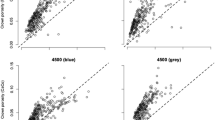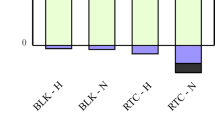Abstract
Monitoring sample plots is important for the sustainable management of forest ecosystems. Acquiring resource data in the field is labor-intensive, time-consuming and expensive. With the rapid development of hardware technology and photogrammetry, forest researchers have turned two-dimensional images into three-dimensional point clouds to obtain resource information. This paper presents a method of sample plot analysis using two charge-coupled device (CCD) cameras based on video photography. A handheld CCD camera was used to shoot the sample plot by surrounding a central tree. Video-based point clouds were used to detect and model individual tree trunks in the sample plots and the DBH of each was estimated. The experimental results were compared with field measurement data. The results show that the relative root mean squared error (rRMSE) of the DBH estimates of individual trees was 2.1–5.7%, acceptable for practical applications in traditional forest inventories. The rRMSE of height estimates was 2.7–36.3%. Average DBH and heights, and tree density and volume were calculated. Video-based methods require compact observation instruments, involve low costs during field investigations, acquire data with high efficiency, and point cloud data can be processed automatically. Furthermore, this method can directly extract information on the relative position of trees, which is important to show distribution visually and provides a basis for researchers to regulate stand density. Additionally, video photography with its unique advantages is a technology warranting future attention for forest inventories and ecological construction.











Similar content being viewed by others
References
Aguilar FJ, Nemmaoui A, Peñalver A (2019) Developing allometric equations for teak plantations located in the coastal region of Ecuador from terrestrial laser scanning data. Forests 10(12):1050
Berveglieri A, Tommaselli A, Liang XL, Honkavaara E (2017) Photogrammetric measurement of tree stems from vertical fisheye images. Scand J For Res 32:1–11
Chen WH, Xu DY, Liu JC (2015) The forest resources input-output model: an application in China. Ecol Indic 51:87–97
Chen SL, Feng ZK, Chen PP, Khan TU, Lian YN (2019) Nondestructive estimation of the above-ground biomass of multiple tree species in boreal forests of China using terrestrial laser scanning. Forests 10(11):936–962
Cheng WS, Feng ZK, Yu JX (2017) Development of generic standard volume model form factor model for major tree species and derived in China. Trans Chin Soc Agric Machin 48:245–252 (in Chinese)
Corona P (2010) Integration of forest mapping and inventory to support forest management. IForest-Biogeosci For 3(1):59–64
Corona P, Marchetti M (2007) Outlining multi-purpose forest inventories to assess the ecosystem approach in forestry. Giornale Botanico Italiano 141(2):243–251
Dalitz C (2017) Iterative Hough transform for line detection in 3D point clouds. Image Process Line 7(2017):184–196
Dick AR, Kershaw JA, Maclean DA (2010) Spatial tree mapping using photography. North J Appl For 27(2):68–74
Feng ZK, Yin JJ, Jia JH, Nan YT (2001) Forest measurement in fixed sample plot by digital close-range photogrammetric survey. J Beijing For Univ 23(5):15–18 (in Chinese)
Forsman M, Börlin N, Holmgren J (2013) Estimation of tree stem attributes using terrestrial photogrammetry. ISPRS Int Arch Photogramm Remote Sens Spat Inf Sci B5:261–265
Forsman M, Börlin N, Holmgren J (2016) Estimation of tree stem attributes using terrestrial photogrammetry with a camera rig. Forests 7(61):1–20
Frey J, Kovach K, Stemmler S, Koch B (2018) UAV photogrammetry of forests as a vulnerable process. A sensitivity analysis for a structure from motion RGB-image pipeline. Remote Sens 10(912):1–12
Gollob C, Ritter T, Wassermann C, Nothdurft A (2019) Influence of scanner position and plot size on the accuracy of tree detection and diameter estimation using terrestrial laser scanning on forest inventory plots. Remote Sens 11(13):1602
Haala N, Stößel W, Gruber M, Pfeifer N, Fritsch D (2013) Benchmarking image matching for surface description, EGU general assembly conference. EGU general assembly conference abstracts
Hauglin M, Astrup R, Gobakken T, Nasset E (2013) Estimating single-tree branch biomass of Norway spruce with terrestrial laser scanning using voxel-based and crown dimension features. Scand J For Res 28(5):456–469
Huang HB, Zhan L, Peng G, Cheng XA, Clinton N, Cao CX, Ni WJ, Lei W (2011) Automated methods for measuring DBH and tree heights with a commercial scanning lidar. Photogramm Eng Remote Sens 77(3):219–227
Huang HY, Zhang H, Chen CC, Tang LY (2018) Three-dimensional digitization of the arid land plant Haloxylon ammodendron using a consumer-grade camera. Ecol Evol 8:5891–5899
Ingwer P, Gassen F, Post S, Huhn M, Schälicke M, Müller K, Ruhm H, Rettig J, Hasche E, Fischer A (2015) Practical usefulness of structure from motion (SfM) point clouds obtained from different consumer cameras. In: Spie/is&t electronic imaging. International society for optics and photonics
Juujarvi J, Heikkonen J, Brandt SS, Lampinen J (1998) Digital image based tree measurement for forest inventory. In: Proceedings of SPIE 3522, intelligent robots and computer vision XVII: algorithms, techniques, and active vision. https://doi.org/10.1117/12.325754
Kaartinen H, Hyyppä J, Yu XW, Vastaranta M, Hyyppä H, Kukko A, Holopainen M, Heipke C, Hirschmugl M, Morsdorf F, Naesset E, Pitkanen J, Popescu S, Solberg S, Wolf BM, Wu JC (2012) An international comparison of individual tree detection and extraction using airborne laser scanning. Remote Sens 4:245–273
Kaartinen H, Hyyppä J, Vastaranta M, Kukko A, Jaakkola A, Yu XW, Pyörälä J, Liang XL, Liu JB, Wang YS, Kaijaluoto R, Melkas T, Holopainen M, Hyyppa H (2015) Accuracy of kinematic positioning using global satellite navigation systems under forest canopies. Forests 6(9):3218–3236
Kangmei L, Zhang YM, Tao Y (2009) Study on Beijing forest fixed sample plot investigation system. For Resour Manag 2:43–48 (in Chinese)
Kenneth O, Johan H, HaKan O (2014) Tree stem and height measurements using terrestrial laser scanning and the RANSAC algorithm. Remote Sens 6(5):4323–4344
Koreň M, Mokroš M, Bucha T (2017) Accuracy of tree diameter estimation from terrestrial laser scanning by circle-fitting methods. Int J Appl Earth Obs Geoinf 63:122–128
Kukko A, Kaijaluoto R, Kaartinen H, Lehtola VV, Jaakkola A, Hyyppä J (2017) Graph SLAM correction for single scanner MLS forest data under boreal forest canopy. ISPRS J Photogram Remote Sens 132:199–209
Leeuwen MV, Nieuwenhuis M (2010) Retrieval of forest structural parameters using LiDAR remote sensing. Eur J For Res 129(4):749–770
Liang XL, Jaakkola A, Wang YS, Hyyppä J, Honkavaara E, Liu JB, Kaartinen H (2014a) The use of a hand-held camera for individual tree 3D mapping in forest sample plots. Remote Sens 6(7):6587–6603
Liang XL, Kankare V, Yu XW, Hyyppa J, Holopainen M (2014b) Automated stem curve measurement using terrestrial laser scanning. IEEE Trans Geosci Remote Sens 52(3):1739–1748
Lin Y, Hyyppa J (2016) A comprehensive but efficient framework of proposing and validating feature parameters from airborne LiDAR data for tree species classification. Int J Appl Earth Obs Geoinf 46:45–55
Liu JC, Feng ZK, Yang LY, Mannan A, Khan TU, Zhao ZY, Cheng ZX (2018) Extraction of sample plot parameters from 3D point cloud reconstruction based on combined RTK and CCD continuous photography. Remote Sens 10(8):1299–1321
Lu JB, Wang H, Qin SH, Cao L, Pu RL, Li GL, Sun J (2020) Estimation of aboveground biomass of Robinia pseudoacacia forest in the yellow river delta based on UAV and backpack LiDAR point clouds. Int J Appl Earth Obs Geoinf 86:102014
Luke W, Arko L, Zbyněk M, Darren T, Petr V (2016) Assessment of forest structure using two UAV techniques: a comparison of airborne laser scanning and structure from motion (SfM) point clouds. Forests 7(3):1–16
Maltamo M, Bollandsas OM, Gobakken T, Naesset E (2016) Large-scale prediction of aboveground biomass in heterogeneous mountain forests by means of airborne laser scanning. Can J For Res 46(9):1138–1144
Mikita T, Janata P, Surový P (2016) Forest stand inventory based on combined aerial and terrestrial close-range photogrammetry. Forests 7(8):1–14
Mlambo R, Woodhouse I, Gerard F, Anderson K (2017) Structure from motion (SfM) photogrammetry with drone data: A low cost method for monitoring greenhouse gas emissions from forests in developing countries. Forests 8(3):68–88
Mulverhill C, Coops NC, Tompalski P, Bater CW, Dick AR (2019) The utility of terrestrial photogrammetry for assessment of tree volume and taper in boreal mixedwood forests. Ann For Sci 76(3):1–12
Næsset E (2002) Predicting forest stand characteristics with airborne scanning laser using a practical two-stage procedure and field data. Remote Sens Environ 80(1):88–99
Nguyen TT, Xuan DP, Jeon JW (2008) An improvement of the Standard Hough Transform to detect line segments. In: IEEE international conference on industrial technology, pp 1‒6
Ojoatre S, Zhang C, Hussin YA, Kloosterman HE, Ismail MH (2019) Assessing the uncertainty of tree height and aboveground biomass from terrestrial laser scanner and hypsometer using airborne LiDAR data in tropical rainforests. IEEE J Sel Top Appl Earth Obs Remote Sens 12(10):4149–4159
Piermattei L, Karel W, Wang D, Wieser M, Mokros M, Surový P, Hollaus M (2019) Terrestrial structure from motion photogrammetry for deriving forest inventory data. Remote Sens 11(8):950–973
Pollefeys M, Gool L, Vergauwen M, Verbiest F, Cornelis K, Tops J, Koch R (2004) Visual modeling with a hand-held camera. Int J Comput Vis 59(3):207–232
Qiu ZX, Feng ZK, Jiang JZW, Lin YC, Xue SL (2018) Application of a continuous terrestrial photogrammetric measurement system for plot monitoring in the Beijing Songshan National Nature Reserve. Remote Sens 10:1080–1103
Reutebuch S, Andersen H, Mcgaughey R (2005) Light detection and ranging (LIDAR): an emerging tool for multiple resource inventory. J For 103(6):286–292
Roberts J, Koeser A, Abd-Elrahman A, Wilkinson BE, Hansen G, Landry SM, Perez A (2019) Mobile terrestrial photogrammetry for street tree mapping and measurements. Forests 10(8):701–717
Trumbore S, Brando P, Hartmann H (2015) Forest health and global change. Science 349(6250):814–818
Wagner B, Ginzler C, Bürgi A, Santini S, Gärtner H (2018) An annually-resolved stem growth tool based on 3D laser scans and 2D tree-ring data. Trees 32(1):125–136
Wu XM, Zhou SY, Xu AJ, Chen B (2019) Passive measurement method of tree diameter at breast height using a smartphone. Comput Electron Agric 163:104875–104886
Xu Q, Hou ZY, Maltamo M, Tokola T (2014) Calibration of area based diameter distribution with individual tree based diameter estimates using airborne laser scanning. ISPRS J Photogramm Remote Sens 93:65–75
Yang SH, Yue DP, Feng ZK, Zheng J (2013) Optimal value selection of trees with polygon plot method. J Northeast For Univ 41(12):26–29 (in Chinese)
Yao ZJ, Yi WD (2016) Curvature aided Hough transform for circle detection. Expert Syst Appl 51:26–33
Yoshimoto A, Surový P, Konoshima M, Kurth W (2014) Constructing tree stem form from digitized surface measurements by a programming approach within discrete mathematics. Trees 28(6):1577–1588
Zeng WS, Zhang LJ, Chen XY, Cheng ZC, Ma KX, Li ZH (2017) Construction of compatible and additive individual-tree biomass models for Pinus tabulaeformis in China. Can J For Res 47(4):467–475
Zhou SZ, Kang F, Li WB, Kan JM, Zheng YJ, He GJ (2019) Extracting diameter at breast height with a handheld mobile LiDAR system in an outdoor environment. Sensors 19(14):3212
Acknowledgements
We are grateful to the staff of the Precision Forestry Key Laboratory of Beijing, Beijing Forestry University. We are also very thankful for the prompt response of the Journal of Forestry Research and its reviewers. The reviewers’ comments were highly beneficial for improving the manuscript draft.
Author information
Authors and Affiliations
Contributions
ZZ and ZF conceived and designed the experiments; ZZ and JL performed the experiments; ZZ and YL analyzed the data; ZZ wrote the main manuscript. All authors contributed in writing and discussing the paper.
Corresponding author
Additional information
Publisher's Note
Springer Nature remains neutral with regard to jurisdictional claims in published maps and institutional affiliations.
Project funding: The work was funded partly by the National Natural Science Foundation of China (Grant number funded this research U1710123) and the Fundamental Research Funds for the Central Universities (No. 2015ZCQ-LX-01).
The online version is available at http://www.springerlink.com
Corresponding editor: Tao Xu.
Rights and permissions
About this article
Cite this article
Zhao, Z., Feng, Z., Liu, J. et al. Stand parameter extraction based on video point cloud data. J. For. Res. 32, 1553–1565 (2021). https://doi.org/10.1007/s11676-020-01173-z
Received:
Accepted:
Published:
Issue Date:
DOI: https://doi.org/10.1007/s11676-020-01173-z




